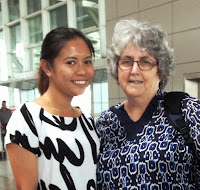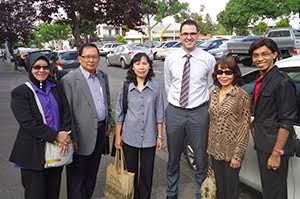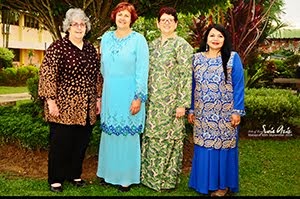Date : 3rd May 2010 (Monday)
Venue : Tallangatta Secondary College

Period 1 :
INTRODUCTION TO STAFF
Meet with Albert Freijah, Principal of Tallangatta Secondary College and Con Madden, Assistant Principal. Introduced to other teachers and staffs of Tallangatta Secondary College.
DAILY BRIEFING
Then all the teachers had short meeting just 10 minutes before 9.00 o’clock where they had briefing and short announcement from principal, assistant principal and other teachers. These take place at the beginning of each day, starting at 8.45am. All staff are expected to attend. A student daily bulletin is distributed at briefing for communication with students as part of the home group routine at the beginning of each day. Information for inclusion on the bulletin is to be placed electronically in the C Staff folder for the appropriate day by 2.30pm on the previous day. The bulletin is printed at 8.30am each morning.
HOMEGROUP MEETING
After staff meeting, all teachers had a Homegroup meeting at designated places for 10 minutes. Homegroup is where a teacher is assigned a few students from different year level to :
• Daily roll marking and administrative procedures through Home Group meetings.
• Advocating for the students in their Home Group
• Monitoring the social and emotional development of each student
• Encouraging positive behaviours and work habits
DISCUSSION WITH PRINCIPAL AND ASSISTANT PRINCIPAL
After homegroup meeting I had a short discussion with Mr Albert Freijah, Principal and Mr Con Madden, Assistant Principal and Janet Floyd, a Senior Leading Teacher and Curriculum Co-ordinator. We discussed on education culture in Malaysia and Australia, school organizational structure and the current activities of reviewing 2009 Action Plan. The process of reviewing their action plan includes diagnostic, feedback from students, teachers, parents and other staff.
Period 2:
SCHOOL ORIENTATION
Went on tour of the school with School Captain, Jacintha, Maddy and Teagan. TSC has 7 buildings which were the main buiding, Year 12 Senior Student Centre, Design and Technology building, English Class building, Music Class building, Locker building and the Sports Centre building.
Offices in the main building are :
1. Administrative office
2. Principal office
3. Assistant Principal office
4. Library
5. Staff Room
6. Food Technology Kitchen
7. Classes
8. Photocopying areas
9. Sick Room
10. Classes

Period 3 :
CLASS VISIT – Visual Art
Visited Sue Ledsam’s art class at Design and Technology Building. In this class she instructed the students to create reports on activities they had done before which was sculpture building. She graphically draw the overall view of the reports assigned on the whiteboard.
A discussion with her later revealed that Visual Communication subject was similar to Visual Arts subject in Malaysia whereas the Studio Art subject mostly focused on sculpture building and photography.

Period 4 & 5 :
CLASS VISIT – Mathematic
Visited Jacqui Veal’s VCE mathematic class for year 12. She was using ICT technology to deliver the content on Probability topic. Technology used were powerpoint presentation with relevant graphics, LCD projector, screen and whiteboards. Teaching and learning then followed by exercises and discussions with individual students.
Period 6 & 7 :
DISCUSSIONS – ICT
Infrastructure
Janet and I had discussions with Mr Geoff Love, an ICT and multimedia teacher who also incharge of the ICT wellbeing of the school. There are 75 computers that were networked throughout the school, 55 laptops for teachers, LCD projectors and 4 interactive whiteboards, wireless access point and network cables. Network computer, colour printer and Internet access is available on all network computers throughout the college. Laptop trolleys are located in the Maths area, the science area, the technology area, , and the Languages area. Ben is a student IT Technician who is available every Tuesday.
Sofware
Sofware installed in most of the computers were Adobe Photoshop, Office 2007, Markbook (for assessment reporting) and the Learning Management System which is located at their school intranet.
Website and LMS
The school website was developed by Mr Geoff Love using Joomla while theLearning Management Sytem (LMS) was created using an open source software, Moodle. Student Digital Portfolio were designed with Mahara software where students posted their sample of work, their reflections and anything that involved especially with their Personal Best Program activities.
Some of the LMS for certain subject needed a username and password even though they are in the same protected intranet. The reason was in that particular LMS, students pictures may be posted where Australia had a strict policy on privacy. Teachers are not allowed to posted any pictures of their students over the internet.
However the use of LMS in the future is uncertain due to the development of ULTRANET by the government which connect all schools in Victoria.
Sister School on LMS
Mr Geoff Love created an account for me to start the discussions of Sister School activities on the LMS. This is to enable teachers and students of TSC and SMKDPM to keep informed of the activities of Sister School.

Homestay
Homestay with Sue

SIMILARITIES
- Similarities in basic school infrastructure.
- Similarities in teachers are teaching and students are learning.
- Similarities in teaching and learning of Arts and Mathematics in terms of technology wise.
DIFFERENCES
- Subject syllabus and assessment were created by the teacher who teach the subject by following guidelines by the Department of Education and Early Childhood Development (DEECD).
- Daily briefing is very short, simple and direct to the point. In complete contrary to our school’s weekly morning prayer.
- TSC had a comprehensive style of reviewing their action plan which involved getting feedback from students and parents in written form.
- The school started at 9.00 am until 3.20 pm with 30 minutes recess time in the morning and another 30 minutes of lunch time.
- Very small number of students in class which usually on the average of 20.
- Numerous and latest ICT infrastructure such as interactive whiteboard, videoconferencing , intranet and high technology of scanner vs photocopying machine which can be sent to their email.
- Communication between principal and teachers are strengthen through the use of local intranet email.
- Students of Year 12 had a special privilege where they have their own building to rest when they had no class.
- In TSC, the students and teachers moved to their classes in rooms designated to them at specific time which keep changing everyday.
































































